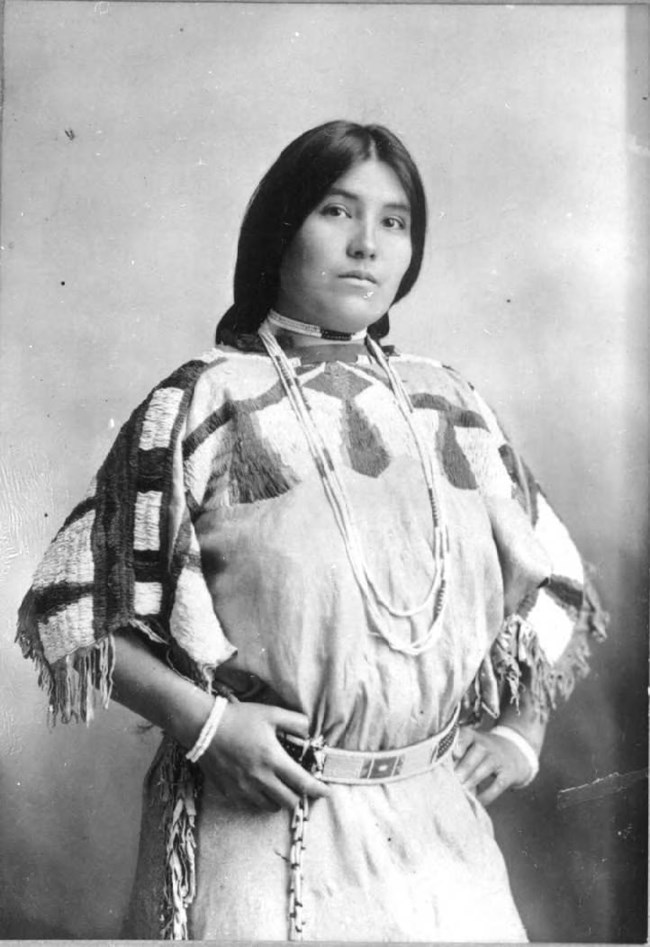Part of a series of articles titled Home and Homelands Exhibition: Resistance.
Article
Elizabeth Penney Wilson nimipuutímt Recording
“We were always more close to my mother, talking to her and she talking to us,” recalled Elizabeth Penney Wilson in a 1970 interview. “‘Ma ma mama,’ we’d say in Indian, so we naturally just talked Indian.”1 When listening to Elizabeth, it is easy to grasp how “nimipuutímt, the Nez Perce language, is a bridge to Nez Perce culture.”2
Elizabeth was born on January 21, 1882 in the middle fork area of the Clearwater River near Kooskia, Idaho to a Nez Perce mother, tukpé-me, and a white father, Benjamin Penney. For most of her life, Elizabeth lived on the Nez Perce Reservation except when she left to attend the Carlisle Indian Boarding School, 2,000 miles away from her home in Pennsylvania, from 1902-1909. Forbidden to speak her native language at school, she mastered English and became an accomplished pianist.

NPS Collections, NEPE-HI-2931.
Cultural Preservation
Elizabeth’s superb memory and command of nimipuutímt led her to become a trusted cultural expert at a time when not many were sharing information about traditional Nez Perce culture. Worried about younger people who could not speak the Nez Perce language and what this would mean for her people’s homeland, she decided to take part in a language study with Haruo Aoki, a U.C. Berkeley linguist, from 1960-1972.4
Through her work with Aoki, Elizabeth was interviewed on several occasions by Loran Olsen, an ethnomusicologist specializing in the music and culture of Native American peoples. Today, the Nez Perce National Historical Park holds these recorded interviews, and they showcase Elizabeth’s compelling voice, gift for storytelling, and love of nimipuutímt. The recording extracted below captures a moment when Elizabeth, asked what a particular “Indian hymn” says, begins singing. Rather than translating it, she sings the hymn in nimipuutímt so that Olsen can hear the beauty in the sound of the words.
-
Elizabeth Penney Wilson Sings a Hymn in nimipuutímt
Elizabeth Penney Wilson—a Nez Perce tribal member who attended the Carlisle Indian Boarding School from 1902-1909—sings a hymn in nimipuutímt, set to the tune of "Auld Lang Syne."
- Credit / Author:
- Elizabeth Penney Wilson, interview by Loran Olsen, September 23 1971. Nez Perce Music Archive. National Park Service, Nez Perce National Historical Park, Lapwai, Idaho.
What Elizabeth likely understood was that much is lost in translation, and to capture the essence of her people, their home, and ways of being in the world, the Nez Perce language needed to be preserved.
The Creation of the Nez Perce Dictionary
Traditionally, nimipuutímt was learned orally. The onslaught of English-speaking settlers and the government-run Indian boarding school system forced children to abandon indigenous cultural practices and the number of native speakers declined. Today, the language is considered critically endangered, spoken by about forty people with varying levels of fluency.5Aoki, with the collaboration of Elizabeth and other elders, created the Nez Perce dictionary. Published in 1994 after thirty years of labor, it is far more than just a dictionary.6 Aoki’s 1,280 page tome is the first definitive written system of nimipuutímt. He incorporated the knowledge of elders like Elizabeth to not only document the meaning, pronunciation, and spelling of the language but also to contextualize it by showing how each word has been used in Nez Perce oral traditions. By recording the lifeways and philosophies embedded in the words, Aoki created a tool that captures an endangered past for present and future generations of nimipuutímt speakers.7

Haruo Aoki, Nez Perce Dictionary (Berkeley: University of California Press, 1994), 506-507.
It was her personal knowledge of language, history, oral tradition, people, and places that has shaped almost every major twentieth century study of Nez Perce culture. Aoki said it best, simply writing, “She was a great teacher.”8
1 Elizabeth Penney Wilson, interview by Loran Olsen, October 30, 1970, Nez Perce Music Archive, National Park Service, Nez Perce National Historical Park, Lapwai, Idaho.
2 This is a direct statement from the Nez Perce Language Program.
3 Biographical information is from Haruo Aoki, Nez Perce Texts (Berkeley: University of California Press, 1979), 8-9; and Haruo Aoki and Deward E. Walker, Nez Perce Oral Narratives (Berkeley: University of California Press, 1989), 4-5.
4 “Elizabeth Wilson Guardian of Traditions,” Lewiston Tribune, May 6, 1990.
5 Language of the Month November 2021: Nez Perce – The National Museum of Language (languagemuseum.org)
6 Yasmin Anwar, Japan-born Linguist Honored for Writing the Book on Nez Perce, Berkeley News, November 9, 2017.
7 Wil Phinney “Historians, Tribes Honor Three Giants in Documenting Plateau Languages for Future Generations,” Oregonian, November 12, 2022.
8 Aoki, Nez Perce Texts, 9.
Last updated: June 11, 2024
